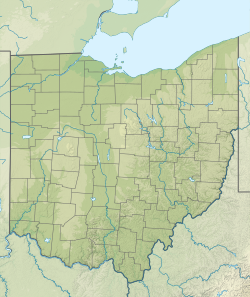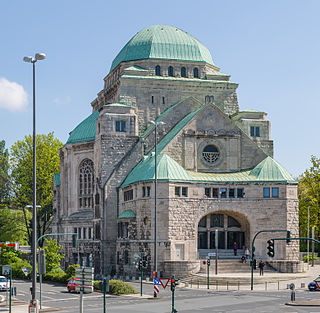
The Old Synagogue in Essen is one of the largest, best preserved and architecturally most impressive testimonies to Jewish culture in pre-war Germany. Built in the centre of the city, the Byzantine style former Synagogue was originally consecrated as the Neue Synagoge in 1913; it now houses an institution dedicated to documenting and promoting the history of the city's former Jewish community.

The Edwin C. Denby High School is a public secondary education school located at 12800 Kelly Road in northeastern Detroit, Michigan. Denby High opened in 1930, and the building was listed on the National Register of Historic Places in 2005. It is a part of Detroit Public Schools Community District.
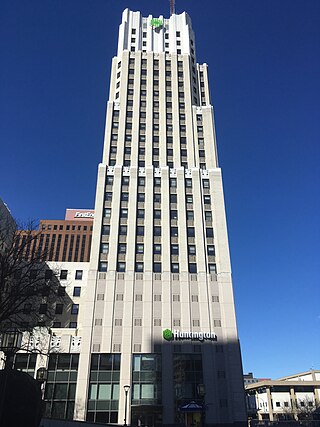
Huntington Tower, earlier known as FirstMerit Tower,First National Bank Building, the First Central Tower and the First Central Trust Building, is a skyscraper in Akron, Ohio. The centerpiece of downtown Akron, it sits in the Cascade Plaza at the corner of King James Way and East Mill Street. The 330 ft (100 m) tower has been the city's tallest building since its completion in 1931.

The United States Post Office Canal Street Station, originally known as "Station B", is a historic post office building located at 350 Canal Street at the corner of Church Street in the Tribeca neighborhood of Manhattan, New York City. It was built in 1937, and designed by consulting architect Alan Balch Mills for the Office of the Supervising Architect of the United States Department of the Treasury.

The U.S. Post Office-Naugatuck Main, also known as Naugatuck Main Post Office, is a historic former post office building at Church and Cedar Streets in Naugatuck, Connecticut. Designed in 1915 and completed the following year, it is one of the most architecturally sophisticated post office buildings in the state. It is set among a cluster of civic buildings designed by McKim, Meade & White. The building was listed on the National Register of Historic Places in 1986. Naugatuck's current post office is located at 170 Water Street.

The Bakersfield Californian Building, also known as the Bakersfield Californian Building, is a historic office building in Bakersfield, California. The structure was placed on the National Register of Historic Places (NRHP) on March 10, 1983. It was built for the newspaper The Bakersfield Californian.

The Main–Market Historic District is a historic district located in Akron, Ohio. It was added to the National Register of Historic Places in 2003.

Congregation Beth El of Flatbush, or simply, Beth El of Flatbush, is an Orthodox Jewish congregation and synagogue, located at 2181 East 3rd Street, in Brooklyn, New York City, New York, United States. The congregation worships in the Sephardic rite.
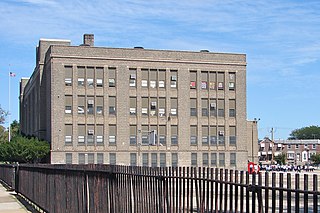
The James J. Sullivan School is a historic elementary school that is located in the Frankford neighborhood of Philadelphia, Pennsylvania, United States.

Ethan Allen School is a K–8 school which is located in the Mayfair neighborhood of Philadelphia, Pennsylvania. It is part of the School District of Philadelphia.

The Anthony Wayne School is a historic former school building located in the Grays Ferry neighborhood of Philadelphia, Pennsylvania, United States. It was designed by Henry deCoursey Richards and built between 1908 and 1909.

The S. Weir Mitchell Elementary School is an historic, American elementary school that is located in the Kingsessing neighborhood of Philadelphia, Pennsylvania. It is part of the School District of Philadelphia.

Henry C. Lea Elementary School is an historic elementary school which is located in the Walnut Hill neighborhood of Philadelphia, Pennsylvania. It is part of the School District of Philadelphia and was named after the publisher, civic activist and historian Henry Charles Lea.

Temple B'Nai Israel is a deconsecrated synagogue located in Olean, Cattaraugus County, New York, in the United States. The synagogue was erected in 1929, closed in 2019 and was deconsecrated in December 2020; the building was listed on the National Register of Historic Places in 2012 and has been used as a community theater since the deconsecration. The B'Nai Israel Congregation that occupied the synagogue, a Conservative/Reform Jewish congregation established in 1894 as the Olean Hebrew Association, continues to operate using rented space elsewhere in Olean.

The Civic Center Financial District is a historic district composed of five buildings near the intersection of Colorado Boulevard and Marengo Avenue in Pasadena, California. The Security Pacific Building and the Citizens Bank Building are located at the intersection itself and considered the centerpieces of the district, while the MacArthur, Mutual, and Crown Buildings are located on North Marengo. The buildings, which were built between 1905 and 1928, are all architecturally significant buildings used by financial institutions in the early 20th century.
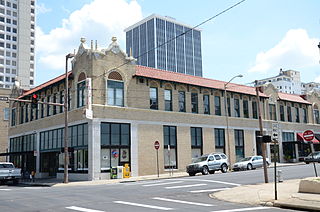
The Moore Building is a historic commercial building at 519-23 Center Street in Little Rock, Arkansas. It is a two-story brick building with Mission Revival styling, designed by Thompson, Sanders & Ginocchio and built in 1929. It has an orange tile parapet roof, with parapetted corners, and periodic use of decorative tiles and terra cotta panels on its two street-facing facades.

The First National Bank of Rock River was built in 1919 in the small community of Rock River, Wyoming, at the peak of a local oil boom and operated from February 1920. The bank closed its doors on April 11, 1923 as the oil boom collapsed and its vice president was convicted of embezzlement. The bank went into receivership on June 14, 1923 and its building sold to the new Citizen's State Bank, but was claimed by Albany County for back taxes in 1931. In 1936 the county sold the building to the town. It became a civic center for the town, operating a post office until the 1950s. A doctor's office had occupied the rear in the 1920s, and in the 1940s apartments were built, which later became the town's jail. With the departure of the post office the building became a fire station. From 1935 to 1985 the Council Room was used by civic organizations. From 1940 to 1985 another room was the town library.

The New Center Commercial Historic District is a commercial historic district located on Woodward Avenue between Baltimore Street and Grand Boulevard in Detroit, Michigan. It was listed on the National Register of Historic Places in 2016.

The Vesper-Buick Auto Company Building, at 3900-3912 W. Pine in St. Louis, Missouri, was built in 1927. It was listed on the National Register of Historic Places in 1986.

Beth-El Zedeck Temple, originally known as Beth-El Temple, is a historic synagogue located in the Mapleton-Fall Creek neighborhood in Indianapolis, Indiana, United States. The building was completed in 1924, and was originally home to Congregation Beth-El before merging with the Ohev Zedeck congregation in 1928. It is the oldest remaining synagogue structure in Indianapolis.

